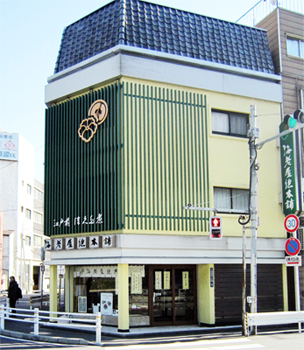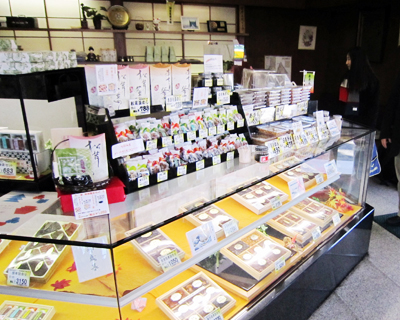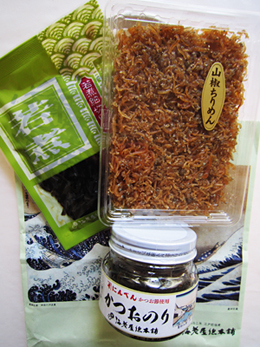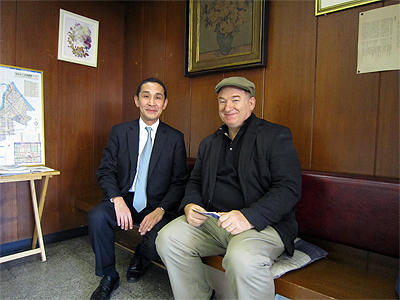 |
セインさん。今日は、浅草駅から東へ。吾妻橋を渡ってすぐの交差点の角にある佃煮の老舗「海老屋總本舗」をお訪ねします。
Thayne-san, today we’re going east of Asakusa Station. We’ll visit a long-established tsukudani shop, the Ebiya Sohonpo, on the corner of the intersection just across the Azumabashi Bridge. |
|
|
 |
吾妻橋からの景色、すばらしいですね。目の下には隅田川、見上げれば東京スカイツリー。そして、アサヒビール本社の印象的なオブジェが目の前に。
The view from Azumabashi Bridge is great. We have a great view of the Sumida River, and if we look up we can see the Tokyo Skytree. There’s also the Asahi Beer Headquarters with the very unusual object on top. |
|
|
 |
はい。春には隅田川の両岸が、桜で彩られてますます美しい景色になりますよ。
That’s right. Both sides of the Sumida River will be even more beautiful when they’re decorated with cherry blossoms in the spring. |
|
|
|

(外観/Exterior) |
|
|
| (川北) |
こんにちは。セインさん、コンシェルジュさん。当主の川北です。
Kawakita-san: Hello Thayne-san and Concierge-san. My name is Kawakita, the head of the company. |
|
|
  |
こんにちは川北さん。今日はよろしくお願いします。それにしても、すばらしいロケーションですね。
Hello Kawakita-san. Nice to meet you today. This is a great location. |
|
|
| (川北) |
ありがとうございます。実は初代がここに店を構えた明治2年(1869)当時は、景色がいいというだけじゃなかったんです。隅田川の水が澄んでいてきれいでしたから、白魚や川エビ、フナなどの魚介類がよく獲れたんです。ですから……。
Kawakita-san: Thank you. Actually, when the business was first located here in 1869 by the founder, he didn’t choose this spot just for the scenery. It was mainly because of the clear and clean water of the Sumida River. It was a good place to catch icefish, freshwater shrimp, carp and so forth. |
|
|
 |
もしかして、材料費がタダ…!?
So I guess that made ingredients for making tsukudani free. |
|
|
| (川北) |
はい。おまけに、橋を渡った対岸には浅草寺があって、1年中、参拝客がいらっしゃるので、こちらで作ったものを持って橋を渡れば、すぐに売れる。
Kawakita-san: Yes, that’s right. Having Sensoji Temple on the opposite bank of the river is a bonus. There are worshipers all year around, and so we were able to take our products across the river and sell them in no time. |
|
|
 |
すごい! それは儲かったでしょうね(笑)。
Wow, that must have been profitable! |
|
|
| (川北) |
はい、多分(笑)。ですが、ライバルも多いので、代々が工夫をしてきています。特に2代目は関西に修業に出て、シソやショウガ、山椒といった香味料を駆使する繊細な味付けを覚えて帰りました。また当時は、関東で佃煮といえば醤油だけで味をつけるのが一般的だったんですが、砂糖を加えて甘辛く煮ることを始めて大ヒットさせたのも2代目です。
Kawakita-san: Yes, perhaps, but there were a lot of rivals, so we had to be innovative to stay in business. The second generation owner was especially innovative. He spent some time training in Kansai, and learned to take advantage of delicate flavorings such as ginger, shiso and pepper. Before that, in the Kanto area, most of the flavoring was done using just soy sauce, but the second generation owner also started to use sugar, giving the tsukudani a sweet flavor, which became a big hit. |
|
|
 |
今では砂糖を使う佃煮は当たり前ですが、当時は画期的なアイデアだったんですね。
It’s now common to use sugar in tsukudani, but at that time, it was quite revolutionary, then? |
|
|
| (川北) |
ええ、そうですね。いまでも当店の佃煮は、やや甘口の薄味ということで評判をいただいています。
Kawakita-san: Yes, that’s right. Our tsukudani still has a reputation for having a light, slightly sweet flavor. |
|
|
 |
それにしても、佃煮って、こうしてみるとものすごいバラエティがあるんですね。1年中、だいたい同じ種類を置いているんですか?
So it looks like there are all kinds of tsukudani―so much variety. Does the type of tsukudani stay the same throughout the year? |
|
|
|

(店内/Store) |
|
|
| (川北) |
1年中あるものもありますし、その時期においしくなる素材は、季節限定で扱います。
Kawakita-san: Some are the same throughout the year, but there are also some seasonal items served when they taste the best. |
|
|
 |
佃煮は保存食のイメージがありますが、野菜も魚介類も、ちゃんと旬があるんですね。
I think most people think of tsukudani as being a way to make food last a long time, but you also have vegetables and fish tsukudani in season? |
|
|
| (川北) |
どうぞ、いろいろ試食してみてください。
Kawakita-san: Yes, please try some of them. |
|
|
 |
「小海老の佃煮」、これおいしいですね。ビールがほしい(笑)。
The boiled shrimp is delicious. It would go great with beer! |
|
|
 |
「若煮細切り昆布」も食べやすい!
The shredded kelp tsukudani is really easy to eat! |
|
|
 |
ほんとだ。「山椒ちりめん」も、ちょっとあっさり味ですね。この海苔の佃煮なんて、ご飯があったらいくらでも食べてしまいそうです!
That’s true. The sansho (Japanese pepper) baby sardines have a nice light taste. With some rice, I’m sure I couldn’t stop eating it! |
|
|
| (川北) |
ありがとうございます。それは、鰹節の「にんべん」さんとコラボレーションした「かつおのり」という商品なんです。
Kawakita-san: Thank you. What you’re trying now is dried and shaved bonito and seaweed, made in collaboration with a foods company called Ninben. |
|
|
|
 |
|
|
 |
佃煮って、どこのお店のものも同じようなものだと思っていましたが違うんですね。
I thought tsukudani was all the same, but I guess that’s not true. |
|
|
 |
セインさん。昨年秋に東京駅にできたお土産品コーナー「Tokyo me+(トウキョウ ミタス)には東都のれん会のお店もたくさん入ったんですが、なんと3軒の佃煮屋さんが軒を並べているんです。3軒で買って、詰め合わせることもできるんですよ。
Actually, last autumn in Tokyo Station, a gift-shop corner was set up called Tokyo Mitasu. There are several Toto Norenkai shops there, and also three tsukudani shops. You can even buy whatever you want from any of the shops and put them together to make a gift pack. |
|
|
 |
斬新ですね! じゃあ、あちこちで買って食べ比べができますね。
That’s a new idea! So you can try a lot of different flavors. |
|
|
| (川北) |
やりにくいところも正直あるんですが、お客様は大変喜ばれていますし、私たちも刺激を受けますから、いい試みだと思っています。
Kawakita-san: To be honest, it’s kind of hard for us to do it that way, but the shoppers really like it. It really made us think about how we do business, so it was a good experiment. |
|
|
 |
老舗は一見、保守的だと思われがちですが、店主の皆さんにお話を聞くと、とても挑戦的ですね。
I kind of think of the traditional Toto Norenkai shops as being really conservative, but it seems like everyone is very willing to try new things. |
|
|
| (川北) |
父からは「変えないものと、変えていくものをきっちり見極めろ」と言われています。
Kawakita-san: My father used to always say, “Make a distinction between the things you change and the things you don’t change.” |
|
|
 |
なるほど。ちゃんとそうやって大事なことを伝えていらっしゃるんですね。 川北さんは小さい頃から、将来は店の跡を継ぐのだと言われながら育ったんですか?
I see. So that’s how important lessons are handed down from one generation to the next? Did you grow up knowing that you would someday take over the family business? |
|
|
| (川北) |
いや、そんなことはありません。ただ、私で5代目になるんですが、いつかは継ぐのだろうなあとは思っていました。でも、大学を出たあと、銀行の営業マンを15年間もやっていたんですよ。
Kawakita-san: No, I didn’t. However, I realized I was the fifth generation, and that I would someday take the place of my father. But after college, I worked for a bank in sales for 15 years. |
|
|
 |
それはなかなかのベテランですね。
That’s quite a long time. |
|
|
| (川北) |
ええ。食品会社の担当などもさせていただいて、いい勉強をさせてもらいました。責任のある仕事も任されて毎日が充実していましたし、部下もできて人間関係も厚みを増してくる時期ですので、やめる時はちょっと辛かったですね。家業を継いで、今年で12年になりました。
Kawakita-san: For a while, I was in charge of the food company section, so it was a good learning experience. It felt good to have the responsibility, and I enjoyed working with my staff, so when it came time to quit, it was really difficult. I’ve now been in the family business for 12 years. |
|
|
 |
今、この仕事で、大切にしていることは何ですか?
Is there an aspect of your job that you especially take pride in? |
|
|
| (川北) |
やはりお客様のご要望に合わせていくことでしょうか。時代に即した商品を開発したり、売り方を変えていったり…。それと、最近は自分の会社だけでなく、この地域とともに栄えていくということを考えるようになりました。 うちは「本所吾妻橋商店会」に属しているんですが、地域の方々と触れ合える場づくりやイベントを区などと協力して作っています。東都のれん会でご一緒の「長命寺桜もち」さんや「言問団子」さん、それからアサヒビールさんなどとも協力して、いろいろなアイデアを持ち寄って。
Kawakita-san: I think it’s meeting the needs of our clients. We have to develop new products for the changing tastes, and also change the way we sell our products. At the same time, I’ve recently been thinking more about how to promote the products from this part of the city and not just my own products. We belong to the Honjo Azumabashi Shop Association, and we try to create events and work with the community to have more opportunities to meet people. Other members of the association include Chomeiji Sakuramochi and Kototoi-dango, both Toto Norenkai members, and also Asahi Beer, and so everyone contributes in a variety of ways. |
|
|
 |
それはいいですね!
That sounds like fun. |
|
|
| (川北) |
はい。ぜひ、イベントにもお越しください。 それと、実はセインさんにお願いがあるんですが、うちは築地にも直営店があって、外国人のお客様が店をのぞかれることも多いのですが、佃煮を簡単に説明するとしたら、どう言ったらいいでしょう。エビの佃煮のようなものなら「フィンガーフード(おつまみ)」だと言うと、だいたいわかってくれるのですが、魚や貝の佃煮などは、どう表現したらいいかと……。
Kawakita-san: Yes, so definitely please come to some of the events. Actually, I have something I’d like to ask you about. We have a shop in Tsukiji, and a lot of foreigners come by and ask us about tsukudani. But how can we explain what tsukudani is in a simple way? I think they understand that shrimp tsukudani is a type of finger food, but I’m not sure how to explain fish and shellfish tsukudani. |
|
|
 |
洋食には似た物がないので、説明するには骨が折れますが、「甘辛醤油で煮た御馳走」と言えば、おおよそ伝わると思います。もちろん、その美味しさは味わってみなければわかりませんけどね!
That’s not easy because there’s nothing really like it in Western cuisine. But I think if you said something like “delicacies simmered in a sweetened soy sauce” most people will understand. But of course, a taste is worth a thousand words! |
|
|
| (川北) |
なるほど! ありがとうございます。
Kawakita-san: Oh, I see! Thank you. |
|
|
 |
ではスタッフ用に「いなごの佃煮」を買って帰ろうかな。
I’ll have to get some grasshopper tsukudani to give to my staff to try. |
|
|
  |
今日はありがとうございました。
Thank you for your time today. |
|
 |
|
(文)太田美代
(英訳)デイビッド・A・セイン |
 1959年、米国生まれ。証券会社勤務を経て来日し、翻訳・通訳など多岐にわたって活躍。豊富な教授経験を生かし、数多くの英語関係書籍を執筆。近著に『日本人のチョットへんな英語』(アスコム)、『超入門シャドーイング』(主婦の友社)、日本人が使いすぎる英語(PHP文庫)など多数。
1959年、米国生まれ。証券会社勤務を経て来日し、翻訳・通訳など多岐にわたって活躍。豊富な教授経験を生かし、数多くの英語関係書籍を執筆。近著に『日本人のチョットへんな英語』(アスコム)、『超入門シャドーイング』(主婦の友社)、日本人が使いすぎる英語(PHP文庫)など多数。










